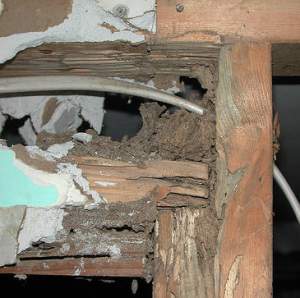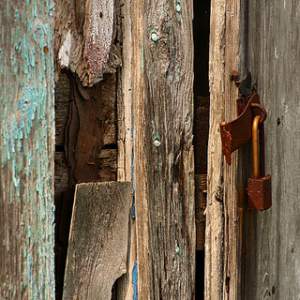How Can You Tell Insect Damage From Wood Rot?
By Chris Williams on May 19, 2014.

Termite-damaged wood
Question
When I was opening up a wall in our basement, I discovered a slow plumbing leak and wet wood that has some kind of damage. The wood is soft and crumbly. Is there any way to tell if that is old termite damage (I don’t see any insects), or if it’s wood rot?—M. W., Clinton MA
Answer
You really need to contact an exterminator who can immediately answer your question. Wood that is rotted or decayed can easily be confused with wood that has been damaged by insect pests such as termites or carpenter ants. To confuse the issue, you often find both decay and insect damage together. That’s because both termites and carpenter ants like to tunnel in wood that has already been softened by decay and moisture. Here are some characteristics of damaged wood:
Color
Decayed wood is darker or lighter in color than normal wood would be. White rot causes wood to have a white, bleached look. Brown rot causes brown streaks on the surface or end grain of the wood. Surface molds can be a powdery green, black, pink, or orange. Insect-infested wood is the same in color as other sound wood.
Texture
Decayed wood is spongy or stringy, or breaks into cubes. You may have already used a screwdriver to dig at the damaged wood. Wood that is not decayed will lift up as long slivers. Decayed wood breaks into short slivers or breaks across the grain without splintering. Brown rot causes wood to crack into cubes. Insect-infested wood doesn’t break into cracks or cubes and is not spongy or stringy. On the outside, the texture may appear normal, but inside insect-damaged wood you will find tunnels or galleries.
Fungus
Decayed woodmay have fruiting bodies that release spores. These look like tiny mushrooms or shelflike brackets. There may be cottony growths, or threadlike strands or fan-shaped mats of mycelia on the wood surface. Insect-infested wood does not have fruiting bodies or mycelia.
Emergence holes
Decayed wood does not have round or oval holes on the surface. Insect-infested woodmay have emergence holes if beetles are infesting. Wood under attack by termites or carpenter ants does not have emergence holes, but carpenter ants can leave slit-like openings in the wood.
Frass or Sawdust
Decayed wood does not have frass (fecal pellets that look like powder) inside or underneath. Insect-infested wood may have frass inside tunnels or underneath exit holes if infested by beetles. Carpenter ants dump shredded sawdust and debris out of their nests through slits in the wood. Their galleries inside the wood are clean and smooth. Termite-damaged wood has tunnels and galleries lined with a muddy paste produced by the termites.
Top Photo credit: Editor B / Foter / Creative Commons Attribution 2.0 Generic (CC BY 2.0)
Bottom Photo credit: Martin Cathrae / Foter / Creative Commons Attribution-ShareAlike 2.0 Generic (CC BY-SA 2.0)
